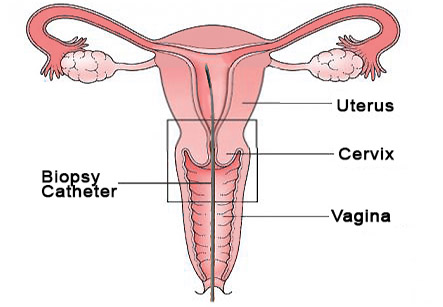Uterine Biopsy
Introduction
An endometrial biopsy is a method for the doctor to take a small sample of the lining of the uterus (endometrium ). The sample is examined under a microscope for abnormal cells. An endometrial biopsy helps doctor to find problems in the endometrium.
The lining of the uterus changes throughout a woman’s menstrual cycle. Early in the menstrual cycle, the lining grows thicker until a mature egg is released from an ovary. If the egg is not fertilized by a sperm, the lining is shed during menstrual bleeding.
Indications:
An endometrial biopsy is performed for various reasons:
• It is done to check for cancer of the uterus. It is usually done to determine the cause of abnormal Pap test results.
• It can also find the cause of heavy, prolonged, or irregular uterine bleeding.
We have all the information you need about public and private clinics and hospitals that provide gynaecological treatment in Iran

• It is often done to find the cause of uterine bleeding occurring in women after menopause.
• Biopsy may be done often to see whether the lining of the uterus (endometrium) is going through the normal menstrual cycle changes and whether it can support pregnancy. This is done for infertility cases.
Preparation:
Before a uterine biopsy, the following should be informed to the doctor:
1. Allergy to any medications
2. Having other diseases like heart disease, diabetes or high blood pressure.
3. Any medications being taken
4. Any blood clotting problems or if blood-thinning agents are being taken like warfarin
5. The patient is or may be pregnant.
6. History of treatment for vaginal, pelvic or cervical infection.
A consent form is signed by the patient regarding the procedure and risks involved. The bladder should be empty. Do not douche, use tampons, or use vaginal medicines for 24 hours before the biopsy.
A pain reliever, such as ibuprofen may be given to the patient about 30 to 60 minutes before having the biopsy. This can decrease any cramping pain that can be caused by the biopsy.
Procedure:
Endometrial biopsy
An endometrial biopsy is usually done by a gynecologist. The sample is examined under microscope by a pathologist. The biopsy can be done in the doctor’s office.
The cervix is usually numbed with a spray or injection of local anesthetic.
Clothes should be taken off below the waist. A drape is given to cover around the waist. The position for the procedure is lying on the back on an examination table with feet raised and supported by foot rests.
An endometrial biopsy is a test to take a small sample of the lining of the uterus (endometrium).
An instrument with smooth, curved blades known as speculum is inserted in the vagina. The speculum gently spreads apart the vaginal walls so the doctor can see inside the vagina and the cervix. The cervix is washed with a special solution and may be grasped and held in place with a clamp called a tenaculum.
The tool to collect the sample is guided through the cervix into the uterus. The tool is then moved up and down to collect the sample. The doctor may use:
1. A soft, strawlike device (pipette) to suction a small sample of endometrium.
2. A sharp-edged tool called a curette. This is called a dilation and curettage.
3. An electronic suction device (Vabra aspiration).
4. A spray of liquid (jet irrigation) to wash off some of the tissue that lines the uterus.
Most women have some cramping during the biopsy.
An endometrial biopsy takes about 5 to 15 minutes.
Side effects:
Without any pain medicine, there may be a sharp cramp as the tool is guided through the cervix. More cramping may be felt when the biopsy sample is collected.
Some women feel dizzy and have pain in abdomen. This is called a vasovagal reaction. This feeling will go away after the biopsy.
An endometrial biopsy usually causes some vaginal bleeding.
Risks
There is a small possibility that the cervix or uterus could be punctured during the biopsy. Bleeding or a pelvic infection can also occur.
After the test
Some soreness may be felt in the vagina for a day or two. Some vaginal bleeding or discharge is normal for about a week after a biopsy. You can use a sanitary pad for the bleeding. Strenuous exercise or heavy lifting should be avoided for one day after the biopsy. Do not have sex, use tampons, or douche until the spotting stops.
Results
An endometrial biopsy is a test to take a small sample of the lining of the uterus (endometrium). Lab results from a biopsy may take several days to get back.
Contraindications for having the endometrial biopsy:
1. Pregnancy
2. A vaginal or cervical infection
If the endometrial biopsy sample is not large enough to see abnormal cells, a repeat test may be needed.